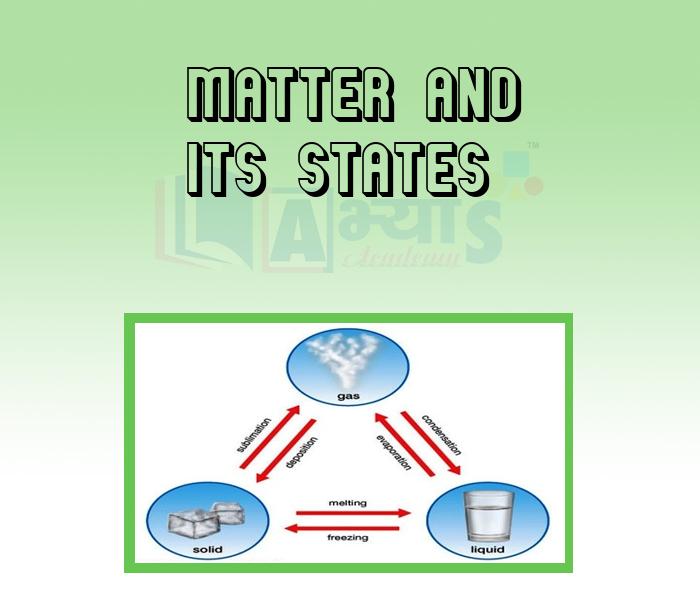Matter And Its States










Matter And Its States
Introduction: Chemistry is the science of the composition of matter, its properties and characteristics, and the changes it undergoes. Chemistry deals with the properties that distinguish one another.
The burning of coal, gas, and wood; the cooking of meat and other foods; the rusting of the kitchen knife and the tarnishing of silver - all these things, which we take for granted, involve chemical changes. Life processes such as growth, digestion and breathing are also examples of chemical change.
States Of matter: The physical classification separates matter into three categories - solids, liquids and gases - known as the three states (phases) of matter. Plasma, highly ionised gas, is sometimes considered a fourth state of matter.
Elements, Compounds and Mixtures: An element may be defined as the simplest form of matter that cannot be decomposed by ordinary chemical means into simpler substances, nor can it be formed by the combination of other substances, or an element is a substance made up of atoms with the same atomic number.
The common examples of elements are hydrogen, oxygen, nitrogen, iron, gold, copper, mercury, carbon, etc. There are 106 elements known at present. Out of these, about 92 have so far been found to occur naturally and the remaining 14 have been prepared in the laboratories.
Oxygen and silicon are the most common elements and they are the major constituents of sand, soil and rocks. Oxygen also occurs as free element in the atmosphere and in combination with hydrogen in water. The most common elements found in 'our body are oxygen, carbon, hydrogen nitrogen, calcium, phosphorus, etc.
A number of elements, found in only very slight traces or not at all in nature, have been synthesised. Those elements are technetium, promethium, astatine, francium and all the elements with atomic number above 92.
Compound: It may be noted that a chemical compound always contains the same elements in definite (fixed) proportion by weight. For example, water always contains hydrogen and oxygen in the ratio of 1:8 by weight. Thus, we may define a compound as a substance made up of two or more elements chemically combined in a fixed proportion by weight, A compound has properties all its own.
Mixtures: Most of the objects that we see around us are not pure substances (like elements and compounds) bat these are mixtures because they contain two or more substances in different proportions. A material obtained by mixing two or more substances (elements or compounds) in any proportion is known as mixture.
Mixtures are of two types: homogeneous mixtures and heterogeneous mixtures.
Students / Parents Reviews [20]
My experience with Abhyas Academy has been very good. When I was not in Abhyas whenever teacher ask questions I could not speak it confidently but when I came in Abhyas, my speaking skills developed and now I am the first one to give the answer of teachers question.

Upmanyu Sharma
7thBeing a parent, I saw my daughter improvement in her studies by seeing a good result in all day to day compititive exam TMO, NSO, IEO etc and as well as studies. I have got a fruitful result from my daughter.

Prisha Gupta
8thA marvelous experience with Abhyas. I am glad to share that my ward has achieved more than enough at the Ambala ABHYAS centre. Years have passed on and more and more he has gained. May the centre flourish and develop day by day by the grace of God.

Archit Segal
7thAbhyas is good institution and a innovative institute also. It is a good platform of beginners.Due to Abhyas,he has got knoweledge about reasoning and confidence.My son has improved his vocabulary because of Abhyas.Teacher have very friendly atmosphere also.

Manish Kumar
10thUsually we see institutes offering objective based learning which usually causes a lag behind in subjective examinations which is the pattern followed by schools. I think it is really a work of planning to make us students grab the advantages of modes of examination, Objective Subjective and Onli...

Anika Saxena
8thIt has a great methodology. Students here can get analysis to their test quickly.We can learn easily through PPTs and the testing methods are good. We know that where we have to practice

Barkha Arora
10thAbhyas academy is great place to learn. I have learnt a lot here they have finished my fear of not answering.It has created a habit of self studying in me.The teachers here are very supportive and helpful. Earlier my maths and science was good but now it has been much better than before.

Barkha Arora
10thOne of the best institutes to develope a child interest in studies.Provides SST and English knowledge also unlike other institutes. Teachers are co operative and friendly online tests andPPT develope practical knowledge also.

Aman Kumar Shrivastava
10thWhen I have not joined Abhyas Academy, my skills of solving maths problems were not clear. But, after joining it, my skills have been developed and my concepts of science and SST are very well. I also came to know about other subjects such as vedic maths and reasoning.

Sharandeep Singh
7thMy experience with Abhyas academy is very nice or it can be said wonderful. I have been studying here from seven class. I have been completing my journey of three years. I am tinking that I should join Abhyas Academy in tenth class as I am seeing much improvement in Maths and English

Hridey Preet
9thWe started with lot of hope that Abhyas will help in better understnding of complex topics of highers classes. we are not disappointed with the progress our child has made after attending Abhyas. Though need to mention that we expected a lot more. On a scale of 1-10, we would give may be 7.

Manya
8thIn terms of methodology I want to say that institute provides expert guidence and results oriented monitering supplements by requsite study material along with regular tests which help the students to improve their education skills.The techniques of providing education helps the students to asses...

Aman Kumar Shrivastava
10thMy experience was very good with Abhyas academy. I am studying here from 6th class and I am satisfied by its results in my life. I improved a lot here ahead of school syllabus.

Ayan Ghosh
8thAbhyas institute is one of the best coaching institute in the vicinity of Ambala Cantt area. The teachers of the institute are well experienced and very helpful in solving the problems of the students.The good thing of the institute is that it is providing extra classes for the students who are w...

Aman Kumar Shrivastava
10thMy experience with Abhyas is very good. I have learnt many things here like vedic maths and reasoning also. Teachers here first take our doubts and then there are assignments to verify our weak points.

Shivam Rana
7thThird consective year,my ward is in Abhyas with nice experience of admin and transport support.Educational standard of the institute recumbent at satisfactory level. One thing would live to bring in notice that last year study books was distributed after half of the session was over,though study ...

Ayan Ghosh
8thAbhyas Methodology is very good. It is based on according to student and each child manages accordingly to its properly. Methodology has improved the abilities of students to shine them in future.

Manish Kumar
10thAbhyas is a complete education Institute. Here extreme care is taken by teacher with the help of regular exam. Extra classes also conducted by the institute, if the student is weak.

Om Umang
10thMy experience with Abhyas academy is very good. I did not think that my every subject coming here will be so strong. The main thing is that the online tests had made me learn here more things.

Hiya Gupta
8thAbout Abhyas metholodology the teachers are very nice and hardworking toward students.The Centre Head Mrs Anu Sethi is also a brilliant teacher.Abhyas has taught me how to overcome problems and has always taken my doubts and suppoeted me.
